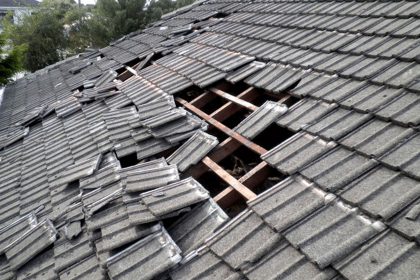 Roofing Material Comparisons
Roofing Material Comparisons
The roof is perhaps the most crucial component of your home. Not only does it keep you secure and comfortable from the wind, rain and cold, but it can make or break the look of the building. There are many choices of roofing material, though, from thatch to metal. So which is the best roofing material type?
Materials for Pitched Roofs
Traditionally, roofs have generally been pitched, and this is still the most common type for individual houses. A number of different materials can work with a pitched roof:
- Clay tiles — Perhaps the most common roof covering, baked clay tiles are relatively cheap, hardy and long-lasting (exceptionally, they can last for centuries). They come in a variety of colours and shapes and can be easily recycled.
- Slates — Natural slates give your roof a stylish look, with various colours available, and are even longer-lasting than clay tiles. They’re also very sturdy and attract less moss. The downside is that they’re expensive, but you can get a similar look from cheaper artificial slate.
- Concrete tiles — Concrete tiles are cheaper than clay ones and are very adaptable. However, they don’t wear so well, so you’ll be having to replace them more frequently.
- Metal — Metal roofs have been around for centuries, but they tend to give a very modern look. Roofs made of copper, zinc or aluminium are lightweight and easy to mould to awkward shapes, but they can be expensive, both for your budget and for the environment, and very appealing to thieves.
- Thatch — There’s little as charming as a thatched roof, and it has the advantage of being a great insulator. It’s relatively easy to fireproof, but it’s expensive and doesn’t last as long as many alternatives.
Materials for Flat Roofs
A modern house may have a flat roof, but it’s more likely that you’ll have one on an extension, annexe or conservatory. There are various alternatives:
- Felt — Modern felt roofing is far higher quality than older systems and is cheap and lightweight. However, it’s not suitable if you’re intending to walk on your roof.
- Single-ply membrane — Materials like PVC, TPO, TPE and PIB are lightweight and flexible and are easy to install. They’re quite expensive, though, and also don’t support footfall.
- Asphalt — An asphalt roof is hard-wearing and suitable for footfall if you want a roof terrace, a roof garden, or even a swimming pool. However, it’s heavy and needs a strong roof structure.
- Liquid rubber — Extremely tough and long-lasting, this protects your roof and provides excellent insulation. It can be laid over existing roofing materials and will bear the weight of regular use. It isn’t easy to install properly, though, so you’ll need to ensure that you use a contractor who specialises in it.
Which is the Best Roofing Material?
As you can probably see, there’s no single answer to that question. The decision depends on a number of factors, such as the type of roof you have, your aesthetic tastes, how you intend to use your roof and what your budget runs to.
If you’re still not sure, you’re very welcome to get in touch to discuss your options.
Read our previous blog post here.
”
{
“”@context””: “”https://schema.org””,
“”@type””: “”BlogPosting””,
“”mainEntityOfPage””: {
“”@type””: “”WebPage””,
“”@id””: “”https://empireupvcandroofing.co.uk/news/roofing-material-comparisons””
},
“”headline””: “”Roofing Material Comparisons | Empire UPVC & Roofing Specialists””,
“”description””: “”There are many choices of roofing material, though, from thatch to metal. So which is the best roofing material type? See more here!””,
“”image””: “”https://empireupvcandroofing.co.uk/wp-content/uploads/2020/06/featured-roofing-material-comparisons-420×280.jpg””,
“”author””: {
“”@type””: “”Organization””,
“”name””: “”Empire Roofing””
},
“”publisher””: {
“”@type””: “”Organization””,
“”name””: “”Empire Roofing””,
“”logo””: {
“”@type””: “”ImageObject””,
“”url””: “”https://empireupvcandroofing.co.uk/wp-content/themes/empire/images/logo.svg””
}
},
“”datePublished””: “”2020-02-18″”,
“”dateModified””: “”2021-05-25″”
}
“









